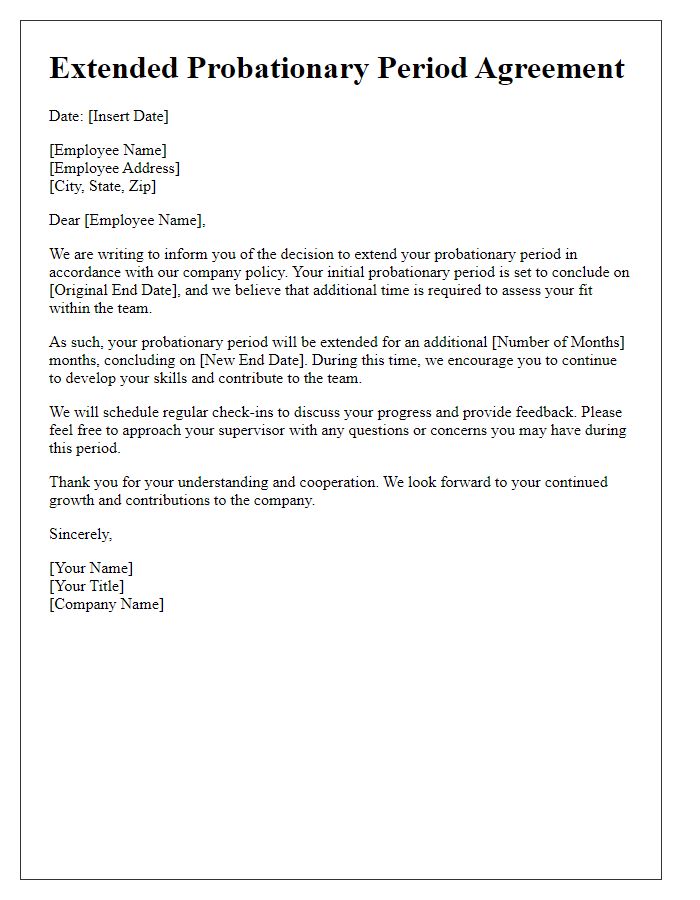If you find yourself in a situation where you need to extend an employee's probation period, crafting the right letter is essential for maintaining clear communication. It's important to approach the subject with a supportive tone, ensuring the employee understands the reasons for the extension and how it relates to their development. This letter should convey a positive outlook on their potential while also outlining any areas for improvement. Want to learn how to effectively structure this letter and what key elements to include? Read on for a detailed guide!

Clear Reasoning and Justification
Prolonged employment probationary periods, typically lasting three to six months, can significantly benefit both employer and employee. Employers may observe that an employee requires additional time to demonstrate proficiency in company-specific systems and protocols or to adjust to the workplace culture at locations such as corporate offices in New York City or remote teams across Europe. Justification for extending the probation period may include specific goals not yet achieved, such as meeting sales targets of $100,000, completing essential training programs, or showcasing collaboration skills within team projects. Clear reasoning for this extension also involves recognizing the complexities of onboarding processes, especially in industries experiencing rapid growth or changes, like tech or healthcare, where employees must adapt to evolving industry standards quickly. Addressing performance concerns while offering support, mentorship, and structured feedback can lead to better long-term outcomes, fostering a more effective and productive employee.
Specific Duration of Extension
During the probationary period for employees, an extension may be required to evaluate performance adequately. A typical extension lasts from 30 days to 90 days, depending on the organization's policies. For example, a 60-day extension allows supervisors to assess if the employee meets the essential job requirements, such as punctuality, teamwork, and productivity standards. This decision often stems from events like missed deadlines or incomplete training. Additionally, employer involvement in regular performance reviews during this period ensures clear communication regarding expectations and improvement areas. Ultimately, the goal is to support employee development while maintaining overall operational efficiency.
Performance Improvement Plan
During the employment probation period, performance improvement plans (PIPs) are often established to help employees address areas requiring development. The PIP outlines specific goals and expectations, typically over a designated timeframe, which may range from 30 to 90 days, depending on the organization's policies. These plans are crucial for assessing progress in key performance indicators (KPIs) such as productivity, quality of work, and teamwork contributions. Employees, like Sarah Thompson at XYZ Corporation, may receive regular feedback sessions, thus enabling constructive dialogue regarding performance issues. Such structured support aims to enhance capabilities, ensuring employees meet or exceed the standards expected for permanent roles, particularly within competitive industries like technology or healthcare.
Support and Resources Offered
Employees facing probation extensions may benefit from various support and resources during this period. Performance improvement plans (PIPs) can provide clear objectives and guidelines to enhance skills and meet company standards. Regular one-on-one meetings with supervisors offer opportunities for feedback, addressing concerns, and discussing progress. Training programs, whether in-house workshops or online courses, can equip employees with necessary competencies for their roles. Access to mentorship programs fosters guidance and encouragement from experienced colleagues. Additionally, employee assistance programs (EAPs) provide confidential support for personal or professional challenges, promoting overall well-being during the extended probation period.
Consequences and Next Steps
Extending an employment probation period can serve as a critical measure for ensuring an employee meets performance expectations. During this probation period, typically lasting three to six months, specific benchmarks related to job duties, productivity metrics, and team collaboration must be closely monitored. If performance falls short, it is essential to communicate clearly, outlining issues such as missed deadlines (e.g., frequent delays in project submissions) and quality of work (e.g., subpar reports generated). The employee should be advised of possible consequences, including potential termination if improvements are not observed. Next steps should be articulated, such as establishing a structured performance improvement plan with regular checks (e.g., bi-weekly meetings for feedback) and setting a new review date, allowing the employee the opportunity to demonstrate progress and align with organizational goals.













Comments